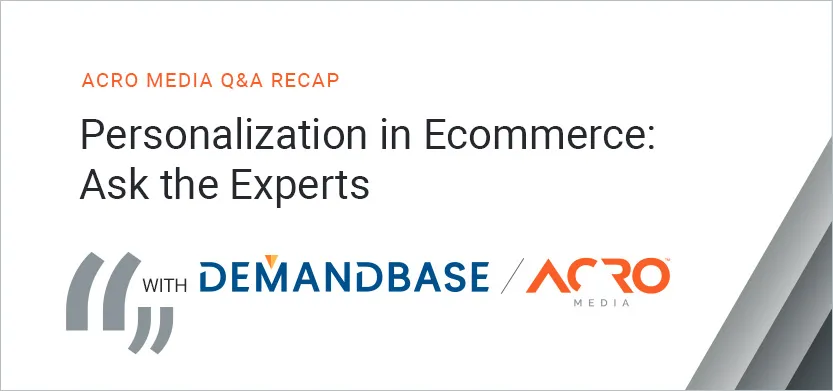
Author
Laura Meshen
, Content Marketing Specialist
Posted in Personalization
June 16, 2021
Acro Commerce Q&A — Personalization in ecommerce: Ask the experts
Matt Gomez, Senior Business Developer at Acro Commerce sits down with Travis Breier, the Product Marketing Manager, at our partner Demandbase to talk about personalization in ecommerce and the tools and tricks retailers can use to leverage personalization.
Key takeaways from the personalization in ecommerce for retail and B2C live Q & A hosted by Acro Commerce.
Click on the links below to jump to the section
WATCH THE SESSION
Timestamps of note:
01:15 — Brief intro to Demandbase and what it does for business.
02:36 — What is personalization, and how does it work?
05:44 — What is the first step in personalization?
06:51 — What kind of metrics should be tracked in personalization
08:55 — Best practices for personalization
12:44 — What is intent data, how is it gathered?
15:57 — Personalization is a full-funnel strategy
17:19 — What does the toolset in Demandbase look like?
18.38 — Can personalization apply across all industries and segments?
23:14 — Do you need to rebuild your technology in order to add personalization?
25:15 — Is personalization expensive?
27:25 — Personalization and digital experience: more than convenience
29:07 — Recap
Listen to this post by using the player, or subscribe using Spotify, Apple Podcasts, or Google Podcasts.
Key takeaways from the conversation
Defining success metrics for personalization
 Once you have undertaken that decision to bring personalization to your online business, what metrics should you be tracking to make sure that you can justify the investment in time, energy and resources?
Once you have undertaken that decision to bring personalization to your online business, what metrics should you be tracking to make sure that you can justify the investment in time, energy and resources?
Metrics and their value will be different for each and every organization, but here are some of the recommendations that Travis touched on in this chat:
- When choosing your metrics, make sure that they are clearly linked to a business goal: increasing sales, improving customer experience, generating revenue, etc.
- Throughout this process, get and keep your entire stakeholder team aligned: conduct stakeholder interviews, have monthly updates sent to the whole group and celebrate wins when they happen.
After those two objectives are met, Travis suggested getting down and dirty with your analytics and picking out select metrics to track and report on:
- Track revenue-related metrics: transactions, sales quantities, and order values.
- Track cost of customer acquisition and retention: loyalty program costs, customer support costs, cost of acquisition and customer lifetime value.
- Track experience-related metrics: conversions, time on page, traffic sources, and bounce rates.
Best practices for personalization
Matt and Travis also talked about the best practices for retailers when it comes to personalization.
- Understand why you are implementing personalization. Really dive into what it will bring to your customer experience, and what it will do to improve your business. Note: not all strategies fit all companies. Start small and build personalization to fit your business needs.
- Define the segments you want to reach. This can’t be stressed enough. Personalization is a hyper-targeted strategy and requires careful consideration of who sees what, when. It is all about the right people seeing the right message at the right time.
- Customize the message and image for each segment. Conversations with different people have different content in real life. That same concept should apply to messaging for your individual business targets.
- Evaluate and test often to refine the experience. Analytics and other ways of testing like surveys and interviews are your best indicators of the successes and failures of your personalization strategies. Use these to tailor your messaging and imagery.
- Leverage the technology and expertise of companies like Demandbase. Quite simply, leaning on experts is the fastest path to success.
Common misconceptions around personalization
There are some misconceptions and myths that surround personalization in ecommerce. Travis broke a few down for us:
- False: Personalization is a “nice to have'' option.
It is in fact, quickly becoming a must-have for digital business. Companies are losing digital sales because of the underutilization of personalization particularly as a means of improving the customer experience - False: Personalization is a huge effort and has to be done all at once.
This is an outright lie. It's one of those things where you can take a stage-by-stage approach. We highly suggest a crawl, walk, run philosophy. - False: Personalization is only about what the customer sees on your website.
Personalization is also about gathering the right data and intent information based on activity so that marketing and sales teams can make better-informed decisions regarding sales tactics, messages and where to approach customers with what kinds of information.
Conclusion
Whether you are just getting started or already have a personalization strategy in place, taking the time to reflect on what personalization means to your business and how it is implemented is always a good use of time. The benefits of a properly implemented personalization strategy with tools like Demandbase outweigh the cost.
If you are considering any sort of transformation in the digital space, especially around ecommerce or digital transformation, Acro Commerce is always here to have a no-hassle conversation with.
If you would like to speak to our panellists directly about this topic, feel free to reach out.
Acro Commerce — Open source ecommerce strategy & technology analysts and development agency
Matt Gomez, Senior Business Developer
Demandbase — Online payment solutions
Travis Breier, Product Marketing Manager

